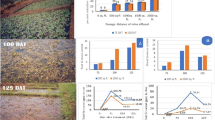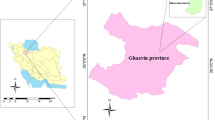Abstract
Mine waste water at South Kaliapani usually contains toxic levels of hexavalent Cr(VI). The present in situ study was conducted at South Kaliapani chromite mine area in Orissa state, India, to assess the phytoremediation ability of three plants, namely, rice (Oryza sativa L.), paragrass (Brachiaria mutica), and an aquatic weed (Eichhornia crassipes), in attenuating Cr(VI) from mine waste water and to correlate the bio-concentration factors (BCF) of Cr. Water hyacinth (E. crassipes) showed 24% to 54% reduction whereas paragrass (B. mutica) was able to reduce 18% to 33% of Cr(VI) from mine water. This reduction was studied over a period of 100 days of plant growth. The reduction was observed through a passage of a sum total of 2,000 sq. ft. cultivated plots and ponds separately. Reduction in Cr(VI) content in mine water varies with plant age as well as with the distance of passage. Cr accumulation and BCF values increased with high soil Cr levels as well as the age of plants. High BCF and transportation index (Ti) values, i.e., 10,924 and 32.09, respectively, were noted for water hyacinth. The Ti values indicated that the root-to-shoot translocation of Cr was very high after 100 days of growth. The total accumulation rate was maximum (8.29 mg Cr kg dry biomass − 1 day − 1) in paragrass. The BCF values for roots were noted to be higher than those of leaves, stems, and grains of the 125-day-old plants. Hence, paragrass and water hyacinth may be used as tools of phytoremediation to combat the problem of in situ Cr contamination.
Similar content being viewed by others
References
Adriano, D. C. (1986). Trace elements in the environment. Chapter 5: Chromium (p. 533). New York : Springer.
APHA (American Public Health Association) (1995). Standard methods for the examination of water and waste water, 19th edn. Washington, DC: American Public Health Association, 20005.
Bath, E. (1989). Effects of heavy metals in soil on microbial processes and populations (a review). Water, Air and Soil Pollution, 47, 335–379.
Bonet, A., Poschenrieder, C. H., & Barcelo, J. (1991). Chromium-III iron interaction in Fe deficient and Fe sufficient bean plants. I. Growth and nutrient content. Journal of Plant Nutrition, 14(4), 403–414.
Erenoglu, B. E., Patra, H. K., Khodr, H., Römheld, V., & Wirén, N. V. (2007). Uptake and apoplasmic retention of EDTA and phytosiderophore-chelated chromium (III) in maize. Journal of Plant Nutrition and Soil Science, 170(6), 788–795.
Dickinson, N. M., & Lepp, N. W. (1997). Metals and trees: Impacts, responses to exposure and exploitation of resistance traits. In R. Prost (Ed.), Contaminated soils, the 3rd International conference on the biogeochemistry of trace elements (pp. 247–254). Paris: INRA.
Dong, J., Wu, F., Huang, R., & Zang, G. (2007). A chromium tolerant plant growing in Cr-contaminated land. International Journal of Phytoremediation, 9, 167–179.
Ghosh, M., & Singh, S. P. (2005a). A review on phytoremediation of heavy metals and utilization of its by-products. Applied Ecology and Environmental Research, 3(1), 1–18.
Ghosh, M., & Singh, S. P. (2005b). Comparative uptake and phytoextraction study of soil induced chromium by accumulator and high biomass weed species. Applied Ecology and Environmental Research, 3(2), 67–79.
HACH (1992). Soil and irrigation water manual, SIW kit. 24960-88. USA.
IBM (Indian Bureau of Mines) (2004). Annual report of IBM. Govt. of India.
Katz, S. A., & Salem, H. (1994). The biological and environmental chemistry of chromium. New York:VCH.
Kharif Manual (2006). Agriculture Department, Orissa University of Agricultural Technology, Government of Orissa, India
Krishnamurthy, S., & Wilkens, M. M. (1994). Environmental chemistry of Cr. Northeastern Geology, 16(1), 14–17.
Mohanty, M., Jena, A. K., & Patra, H. K. (2005a). Effect of chelated chromium compounds on chlorophyll content and activities of catalase and peroxidase in wheat seedlings. Indian Journal of Agricultural Biochemistry, 8(1), 25–29.
Mohanty, M., Pattnaik, M. M., Mishra, A. K., & Patra, H. K. (2005b). Assessment of soil and water quality of chromite mine area of South Kaliapani (Sukinda, Orissa). Bulletin of Environmental Science, 23(2), 109–113.
Mohanty, M., Pattanaik, M. M., Misra, A. K., & Patra, H. K. (2009). Chromium detoxification from mine waste water by rice—a case study at South Kaliapani chromite mine area, Sukinda, Orissa. e-Planet, 7(1), 26–31, ISSN: 0974-4398/2008.
Panda, S. K., & Patra, H. K. (1997a). Physiology of chromium toxicity in plants—a review. Plant Physiology and Biochemistry, 24(1), 10–17.
Panda, S. K., & Patra, H. K. (1997b). Some of the toxicity lesions produced by chromium (VI) during the early phase of seed germination in wheat. Journal of Indian Botanical Society, 76, 303–304.
Panda, S. K., & Patra, H. K. (1998). Attenuation of nitrate reductase activity by chromium ions in excised wheat leaves. Indian Journal of Agricultural Biochemistry, 2(2), 56–57.
Panda, S. K., & Patra, H. K. (2000) Does chromium (III) produce oxidative damage in excised wheat leaves? Journal of Plant Biology, 27(2), 105–110.
Pawlisz, A. V. (1997). Canadian water quality guidelines for Cr. Environmental Toxicology and Water Quality, 12(2), 123–161.
Pulford, I. D., & Watson, C. (2003). Phytoremediation of heavy metal contaminated land by trees—a review. Environment International, 29, 529–540.
Shanker, A. K., Djanaguiraman, M., Sudhagar, R., Chandrashekar, C. N., & Pathmanabhan, G. (2004). Differential antioxidative response of ascorbate glutathione pathway enzymes and metabolites to chromium speciation stress in green gram (Vigna radiata (L.) R.Wilczek) roots. Plant Science, 166, 1035–1043.
Srivastava, S., Prakash, S., & Srivastava, M. M. (1999). Chromium mobilization and plant availability—the impact of organic complexing ligands. Plant Soil, 212, 203–208.
WHO (World Health Organisation) (1997). Health and environment in sustainable development. Geneva
Zayed, A. M., & Terry, N. (2003). Chromium in the environment: factor affecting biological remediation. Plant Soil, 249, 139–156.
Zayed, A., Lytle, C. M., Qian, J. H., & Terry, N. (1998). Chromium accumulation, translocation and chemical speciation in vegetable crops. Planta, 206, 293–299.
Zhang, X. H., Liu, J., Huang, H. T., Chen, J., Zhu, Y. N., & Wang, D. Q. (2007). Chromium accumulation by the hyperaccumulator plant Leersia hexandra Swartz. Chemosphere, 67, 1138–1143.
Zurayk, R., Sukkariyah, B., Baalbaki, R., & Ghanem, D. A. (2002). Ni phytoaccumulation in Mentha aquatica L. and Mentha sylvestris L. Water Air and Soil Pollution, 139, 355–364.
Author information
Authors and Affiliations
Corresponding author
Rights and permissions
About this article
Cite this article
Mohanty, M., Pattnaik, M.M., Mishra, A.K. et al. Bio-concentration of chromium—an in situ phytoremediation study at South Kaliapani chromite mining area of Orissa, India. Environ Monit Assess 184, 1015–1024 (2012). https://doi.org/10.1007/s10661-011-2017-7
Received:
Accepted:
Published:
Issue Date:
DOI: https://doi.org/10.1007/s10661-011-2017-7




